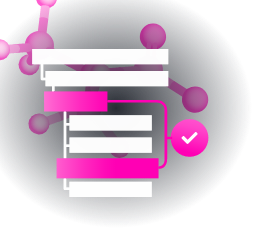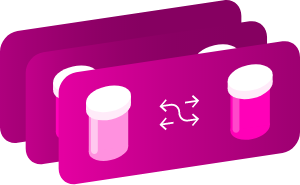This drug entry is astuband has not been fully annotated. It is scheduled to be annotated soon.
Identification
- Generic Name
- Otenabant
- DrugBank Accession Number
- DB11745
- Background
-
Otenabant has been investigated for the treatment of Obesity.
- Type
- Small Molecule
- Groups
- Investigational
- Structure
- Weight
-
Average: 510.42
Monoisotopic: 509.1497639 - Chemical Formula
- C25H25Cl2N7O
- Synonyms
-
- Otenabant
- External IDs
-
- CP-945,598
- CP-945598
- CP-945598-01
Pharmacology
- Indication
-
Not Available
 Reduce drug development failure ratesBuild, train, & validate machine-learning models
Reduce drug development failure ratesBuild, train, & validate machine-learning models
with evidence-based and structured datasets.Build, train, & validate predictive machine-learning models with structured datasets. - Contraindications & Blackbox Warnings
-
 Avoid life-threatening adverse drug eventsImprove clinical decision support with information oncontraindications & blackbox warnings, population restrictions, harmful risks, & more.Avoid life-threatening adverse drug events & improve clinical decision support.
Avoid life-threatening adverse drug eventsImprove clinical decision support with information oncontraindications & blackbox warnings, population restrictions, harmful risks, & more.Avoid life-threatening adverse drug events & improve clinical decision support. - Pharmacodynamics
-
Not Available
- Mechanism of action
-
Pre-clinical and clinical trial data suggest that CB-1 antagonists may have favorable effects on glucose metabolism in patients with type 2 diabetes and may also be an effective therapy for the treatment of obesity.
Target Actions Organism UCannabinoid receptor 1 Not Available Humans - Absorption
-
Not Available
- Volume of distribution
-
Not Available
- Protein binding
-
Not Available
- Metabolism
- Not Available
- Route of elimination
-
Not Available
- Half-life
-
Not Available
- Clearance
-
Not Available
- Adverse Effects
-
 Improve decision support & research outcomesWith structured adverse effects data, including:blackbox warnings, adverse reactions, warning & precautions, & incidence rates.Improve decision support & research outcomes with our structured adverse effects data.
Improve decision support & research outcomesWith structured adverse effects data, including:blackbox warnings, adverse reactions, warning & precautions, & incidence rates.Improve decision support & research outcomes with our structured adverse effects data. - Toxicity
-
Not Available
- Pathways
- Not Available
- Pharmacogenomic Effects/ADRsBrowse all" title="" id="snp-actions-info" class="drug-info-popup" href="javascript:void(0);">
- Not Available
Interactions
- Drug InteractionsLearn More" title="" id="structured-interactions-info" class="drug-info-popup" href="javascript:void(0);">
-
This information should not be interpreted without the help of a healthcare provider. If you believe you are experiencing an interaction, contact a healthcare provider immediately. The absence of an interaction does not necessarily mean no interactions exist.Not Available
- Food Interactions
- Not Available
Products
-
 Drug product information from 10+ global regionsOur datasets provide approved product information including:
Drug product information from 10+ global regionsOur datasets provide approved product information including:
dosage, form, labeller, route of administration, and marketing period.Access drug product information from over 10 global regions. - Product Ingredients
-
Ingredient UNII CAS InChI Key Otenabant hydrochloride X2166Z319O 686347-12-6 KPYUQCJBZGQHPL-UHFFFAOYSA-N
Categories
- Drug Categories
- Chemical TaxonomyProvided byClassyfire
-
- Description
- This compound belongs to the class of organic compounds known as alpha amino acid amides. These are amide derivatives of alpha amino acids.
- Kingdom
- Organic compounds
- Super Class
- Organic acids and derivatives
- Class
- Carboxylic acids and derivatives
- Sub Class
- Amino acids, peptides, and analogues
- Direct Parent
- Alpha amino acid amides
- Alternative Parents
- Phenylimidazoles/6-alkylaminopurines/Piperidinecarboxamides/Dialkylarylamines/Aminopiperidines/Aminopyrimidines and derivatives/Chlorobenzenes/N-substituted imidazoles/Imidolactams/Aryl chlorides show 8 more
- Substituents
- 1-phenylimidazole/2-phenylimidazole/4-aminopiperidine/6-alkylaminopurine/6-aminopurine/Alpha-amino acid amide/Amine/Aminopyrimidine/Aromatic heteropolycyclic compound/Aryl chloride show 31 more
- Molecular Framework
- Aromatic heteropolycyclic compounds
- External Descriptors
- Not Available
- Affected organisms
- Not Available
Chemical Identifiers
- UNII
- J8211Y53EF
- CAS number
- 686344-29-6
- InChI Key
- UNAZAADNBYXMIV-UHFFFAOYSA-N
- InChI
-
InChI=1S/C25H25Cl2N7O/c1-2-31-25(24(28)35)11-13-33(14-12-25)22-20-23(30-15-29-22)34(17-9-7-16(26)8-10-17)21(32-20)18-5-3-4-6-19(18)27/h3-10,15,31H,2,11-14H2,1H3,(H2,28,35)
- IUPAC Name
-
1-[8-(2-chlorophenyl)-9-(4-chlorophenyl)-9H-purin-6-yl]-4-(ethylamino)piperidine-4-carboxamide
- SMILES
-
CCNC1(CCN(CC1)C1=C2N=C(N(C2=NC=N1)C1=CC=C(Cl)C=C1)C1=CC=CC=C1Cl)C(N)=O
References
- 一般References
-
- Heimann AS, Gomes I, Dale CS, Pagano RL, Gupta A, de Souza LL, Luchessi AD, Castro LM, Giorgi R, Rioli V, Ferro ES, Devi LA: Hemopressin is an inverse agonist of CB1 cannabinoid receptors. Proc Natl Acad Sci U S A. 2007 Dec 18;104(51):20588-93. Epub 2007 Dec 12. [Article]
- Buchweitz JP, Karmaus PW, Williams KJ, Harkema JR, Kaminski NE: Targeted deletion of cannabinoid receptors CB1 and CB2 produced enhanced inflammatory responses to influenza A/PR/8/34 in the absence and presence of Delta9-tetrahydrocannabinol. J Leukoc Biol. 2008 Mar;83(3):785-96. Epub 2007 Dec 11. [Article]
- Gerdeman GL, Schechter JB, French ED: Context-specific reversal of cocaine sensitization by the CB1 cannabinoid receptor antagonist rimonabant. Neuropsychopharmacology. 2008 Oct;33(11):2747-59. Epub 2007 Dec 5. [Article]
- External Links
-
- PubChem Compound
- 10052040
- PubChem Substance
- 347828103
- ChemSpider
- 8227602
- BindingDB
- 27337
- ChEMBL
- CHEMBL562668
- ZINC
- ZINC000003948997
- Wikipedia
- Otenabant
Clinical Trials
- Clinical TrialsLearn More" title="" id="clinical-trials-info" class="drug-info-popup" href="javascript:void(0);">
-
Phase Status Purpose Conditions Count 3 Terminated Treatment Obesity 4 2, 3 Completed Treatment Obesity 1 1 Completed Basic Science Non Alcoholic Steatohepatitis (NASH) 1 1 Completed Diagnostic Healthy Subjects (HS) 1 1 Completed Treatment Hepatic Insufficiency/Obesity 1 1 Completed Treatment Obesity 4
Pharmacoeconomics
- Manufacturers
-
Not Available
- Packagers
-
Not Available
- Dosage Forms
- Not Available
- Prices
- Not Available
- Patents
- Not Available
Properties
- State
- Not Available
- Experimental Properties
- Not Available
- Predicted Properties
-
Property Value Source Water Solubility 0.0107 mg/mL ALOGPS logP 3.66 ALOGPS logP 4.42 Chemaxon logS -4.7 ALOGPS pKa (Strongest Acidic) 15.89 Chemaxon pKa (Strongest Basic) 8.97 Chemaxon Physiological Charge 1 Chemaxon Hydrogen Acceptor Count 6 Chemaxon Hydrogen Donor Count 2 Chemaxon Polar Surface Area 101.96 Å2 Chemaxon Rotatable Bond Count 6 Chemaxon Refractivity 158.88 m3·mol-1 Chemaxon Polarizability 53.2 Å3 Chemaxon Number of Rings 5 Chemaxon 生物利用度 1 Chemaxon Rule of Five No Chemaxon Ghose Filter No Chemaxon Veber's Rule No Chemaxon MDDR-like Rule Yes Chemaxon - Predicted ADMET Features
- Not Available
Spectra
- Mass Spec (NIST)
- Not Available
- Spectra
-
Spectrum Spectrum Type Splash Key Predicted MS/MS Spectrum - 10V, Positive (Annotated) Predicted LC-MS/MS Not Available Predicted MS/MS Spectrum - 20V, Positive (Annotated) Predicted LC-MS/MS Not Available Predicted MS/MS Spectrum - 40V, Positive (Annotated) Predicted LC-MS/MS Not Available 预测MS / MS谱- 10 v, Negative (Annotated) Predicted LC-MS/MS Not Available Predicted MS/MS Spectrum - 20V, Negative (Annotated) Predicted LC-MS/MS Not Available Predicted MS/MS Spectrum - 40V, Negative (Annotated) Predicted LC-MS/MS Not Available
Targets

Build, predict & validate machine-learning models
Use our structured and evidence-based datasets tounlock new
insights and accelerate drug research.
insights and accelerate drug research.
Use our structured and evidence-based datasets to unlock new insights and accelerate drug research.
- Kind
- Protein
- Organism
- Humans
- Pharmacological action
-
Unknown
- General Function
- Drug binding
- Specific Function
- Involved in cannabinoid-induced CNS effects. Acts by inhibiting adenylate cyclase. Could be a receptor for anandamide. Inhibits L-type Ca(2+) channel current. Isoform 2 and isoform 3 have altered l...
- Gene Name
- CNR1
- Uniprot ID
- P21554
- Uniprot Name
- Cannabinoid receptor 1
- 分子量
- 52857.365 Da
Drug created at October 20, 2016 20:44 / Updated at February 21, 2021 18:53




